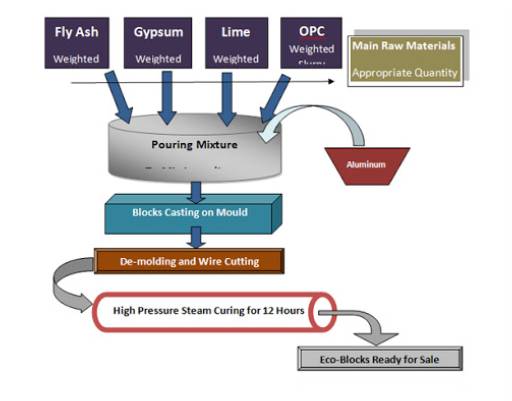AAC blocks are light weight Aerated Autoclave Concrete Block. It is manufactured through a reaction of aluminum powder and a proportionate blend of lime, cement, and fly ash or sand.
Autoclaved aerated concrete (AAC) is a lightweight cellular concrete that has been used for more than 80 years. Currently, however, no good recycling options for AAC from construction and waste exist. During this process, the hydrogen gas escapes create lots (billions) of tiny air cells, applying AAC with a strong cellular structure. The hydrogen gas or bubbles cause the concrete to expand to roughly three times its original volume, further strengthened by high pressure steam curing. The product thus formed is not only light weight concrete but also has higher compressive strength.

By using the BuildECO, you have made a decision to consider the most innovative building material available in today’s market. The combination of fire resistance, thermal efficiency, cost effectiveness & environmental qualities of BuildECO cannot be surpassed by any other building product.
Construction demands are ever changing, requiring building systems to be versatile, efficient and cost effective. BuildECO offers its block products in a multitude of combinations of thickness, height, length and Strength Class sizes that can be utilized in many applications.
Comparison
AAC Blocks are approximately 3 times lighter than conventional bricks and thus results in
- Savings in handling and transportation costs
- Better earthquake resistance
- Great savings in foundation and structural costs due to decrease in overall dead load
- Possibility of additional floors on old structures
- AAC blocks are seven times the size of traditional bricks. These results are substantial savings in Cement due to fewer joints compared to brick work and finished plaster work.
- AAC blocks are factory finished with precise edges & shapes, this result in economical POP or Putty finish and much reduced plaster cost.
- Due to light weight and low density, overall dead load reduces, thus saving structural steel consumption compared to conventional masonry.
- There is increase in carpet area by 3 to 5% depending on design.
- Operating cost savings can be realized through reduction in maintenance, energy bills and insurance.
- AAC block covers greater area for the same mass of brick used thus saves on transportation costs and conserves precious fuel.
- Due to the numerous micropores in AAC, it has a very low thermal conductivity and makes an excellent thermal insulation material.
- It keeps interiors cooler in summer and warmer in winters.
- Due to reduced cooling/heating loads, it reduces air conditioning/heating loads by as much as 25-30%.
- Thus you can use a 2 ton AC in place of a 2.5 ton AC and save on the capital and running costs of the AC.
- Due to reduced operational loads, it saves on electricity bills and conserves nation’s fuel and environment.
- AAC blocks are non-combustible and has a melting point of approximately 1500 degrees Centigrade, much higher than other building materials.
- No toxic fumes are generated during a fire and thus saves precious lives during a fire.

AAC blocks have natural acoustic insulation due to its aerated structure and has superior sound absorption properties in comparison with other materials. It reduces outdoor noise pollution and also saves costs by reducing costs of noise and echo proofing materials.





Moreover Fly Ash (a waste product during Thermal Power Generation) is the MAJOR raw material consisting 60-70% of the total weight. Thermal Power plant waste is effectively used unlike brick manufacturing which degrades and erodes agricultural land, which is already a precious commodity in a highly populated agro based country like India.

AAC blocks have natural acoustic insulation due to its aerated structure and has superior sound absorption properties in comparison with other materials. It reduces outdoor noise pollution and also saves costs by reducing costs of noise and echo proofing materials.

AAC blocks have much lower water retention or capillary action compared to the conventional bricks. AAC blocks are also termite, pest, mold and fungus resistant and hence greatly improve the indoor air quality.

AAC Blocks have proven earthquake resistance due to its light weight and porous structure. The structure has millions of tiny cells which cushions buildings from major force, preventing progressive collapse. Thus it saves lives and response time for rescue operations during earthquake.

It is easy to install with precision. It can be sawn, drilled, nailed, grooved etc on site by Masons using simple working tools. Thus it saves on expensive labor cost as it does not require extra skillful and paid masons or hi-tech tools.

AAC uses the least amount of energy to produce than any other masonry building material. The manufacturing process is such that negligible gaseous, liquid or solid waste is released into the environment.

Moreover Fly Ash [a waste product during Thermal Power Generation) is the MAJOR raw material consisting 60-70% of the total weight. Thermal Power plant waste is effectively used unlike brick manufacturing which degrades and erodes agricultural land, which is already a precious commodity in a highly populated agro based country like India.
